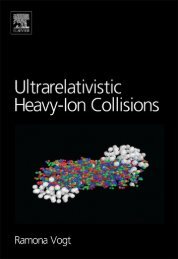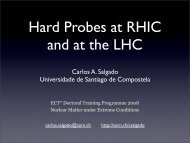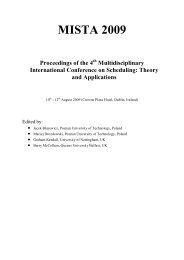Advances in perturbative thermal field theory - Ultra-relativistic ...
Advances in perturbative thermal field theory - Ultra-relativistic ...
Advances in perturbative thermal field theory - Ultra-relativistic ...
You also want an ePaper? Increase the reach of your titles
YUMPU automatically turns print PDFs into web optimized ePapers that Google loves.
Thermal <strong>field</strong> <strong>theory</strong> 373<br />
Figure 7. Three-loop pressure <strong>in</strong> pure-glue QCD with unexpanded effective-<strong>field</strong>-<strong>theory</strong><br />
parameters when ¯µ is varied between πT and 4πT (medium-grey band); the dotted l<strong>in</strong>es <strong>in</strong>dicate<br />
the position of this band when only the lead<strong>in</strong>g-order result for m E is used. The broad light-grey<br />
band underneath is the strictly <strong>perturbative</strong> result to order g 5 with the same scale variations. The full<br />
l<strong>in</strong>e gives the result upon extremalization (PMS) with respect to ¯µ (which does not have solutions<br />
below ∼1.3T c ); the dash-dotted l<strong>in</strong>e corresponds to fastest apparent convergence (FAC) <strong>in</strong> m 2 E ,<br />
which sets ¯µ ≈ 1.79πT (taken from [164]).<br />
Figure 8. Like figure 7, but extended to four-loop order by <strong>in</strong>clud<strong>in</strong>g the recently determ<strong>in</strong>ed<br />
g 6 ln(1/g) contribution of [137] together with three values for the undeterm<strong>in</strong>ed constant δ <strong>in</strong><br />
[g 6 ln(1/g) + δ]. The broad light-grey band underneath is the strictly <strong>perturbative</strong> result to order<br />
g 6 , correspond<strong>in</strong>g to the central value δ = 1 3 , which has a larger scale dependence than the order<br />
g 5 result <strong>in</strong> figure 7; the untruncated results on the other hand show rather small-scale dependence.<br />
The full l<strong>in</strong>e gives the untruncated result with δ = 1 3 and ¯µ fixed by PMS (which does not have<br />
solutions below ∼ 1.9T c ); the dash-dotted l<strong>in</strong>e corresponds to FAC <strong>in</strong> m 2 E , which sets aga<strong>in</strong> to<br />
¯µ ≈ 1.79πT (taken from [164]).<br />
results [137,165]. Furthermore, while a strictly <strong>perturbative</strong> treatment leads to <strong>in</strong>creased scale<br />
dependence compared with three-loop order, keep<strong>in</strong>g the soft contributions unexpanded <strong>in</strong> g<br />
further dim<strong>in</strong>ishes the scale dependence [164] as shown <strong>in</strong> figure 8.<br />
While this goes only m<strong>in</strong>imally beyond a strictly <strong>perturbative</strong> treatment, it strongly<br />
suggests that <strong>perturbative</strong> QCD at high temperature, when supplemented by appropriate<br />
resummation of soft physics, is not limited to T ≫ 10 5 T c as previously thought [133, 135]<br />
but seems capable of quantitative predictions at temperatures of possibly only a few times the<br />
transition temperature.







